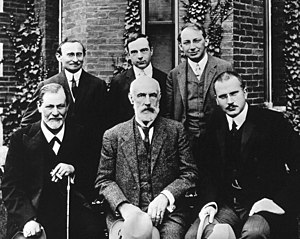
Back ديناميكية نفسية Arabic Психодинамика Bulgarian Teoria psicodinàmica Catalan Psychodynamik German Ψυχοδυναμική ψυχοθεραπεία Greek روانپویهشناسی Persian Psychodynamique French פסיכודינמיקה HE मनोगतिकी Hindi Teori Psiko Dinamika ID

| Part of a series on |
| Psychology |
|---|
Psychodynamics, also known as psychodynamic psychology, in its broadest sense, is an approach to psychology that emphasizes systematic study of the psychological forces underlying human behavior, feelings, and emotions and how they might relate to early experience. It is especially interested in the dynamic relations between conscious motivation and unconscious motivation.[1]
The term psychodynamics is sometimes used to refer specifically to the psychoanalytical approach developed by Sigmund Freud (1856–1939) and his followers. Freud was inspired by the theory of thermodynamics and used the term psychodynamics to describe the processes of the mind as flows of psychological energy (libido or psi) in an organically complex brain.[2] However, modern usage differentiates psychoanalytic practice as referring specifically to the earliest forms of psychotherapy, practiced by Freud and his immediate followers, and psychodynamic practice as practice that is informed by psychoanalytic theory, but diverges from the traditional practice model.[3]
In the treatment of psychological distress, psychodynamic psychotherapy tends to be a less intensive (once- or twice-weekly) modality than the classical Freudian psychoanalysis treatment (of 3–5 sessions per week) and typically relies less on the traditional practices of psychoanalytic therapy, such as the patient facing away from the therapist during treatment and free association. Psychodynamic therapies depend upon a psychoanalytic understanding of inner conflict, wherein unconcious thoughts, desires, and memories influence behavior and psychological problems are caused by unconcious or repressed conflicts. [4][5]
Despite largely falling out of favor as the primary modality of psychotherapy and facing criticism as being "non-empirical", psychodynamic treatment has been shown to be effective at treating a number of psychological conditions in randomized controlled trials, more effectively than controls and to the same degree as other psychotherapy modalities.[6][7]
- ^ What is psychodynamics? — WebMD rehashing Stedman's Medical Dictionary 28th Edition (2006), Lippincott Williams & Wilkins.
- ^ Bowlby, John (1999). Attachment and Loss: Vol I, 2nd Ed. Basic Books. pp. 13–23. ISBN 0-465-00543-8.
- ^ https://www.apa.org/monitor/2017/12/psychoanalysis-psychodynamic
- ^ Adapted from Corsini and Wedding 2008; Corsini, R. J., & Wedding, D. (2008) Current Psychotherapies, 8th Edition. Belmont, CA.: Thomson Brooks/Cole. (pp. 15-17).
- ^ Opland, C.; Torrico, T. J. (2024). "Psychodynamic Therapy". StatPearls. PMID 39163451.
- ^ Fonagy, P. (2015). "The effectiveness of psychodynamic psychotherapies: An update". World Psychiatry. 14 (2): 137–150. doi:10.1002/wps.20235. PMC 4471961. PMID 26043322.
- ^ Lilliengren, Peter (2023). "A comprehensive overview of randomized controlled trials of psychodynamic psychotherapies". Psychoanalytic Psychotherapy. 37 (2): 117–140. doi:10.1080/02668734.2023.2197617.